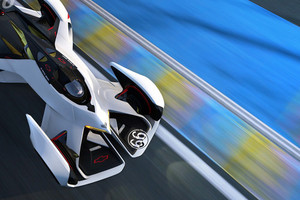
Mitsubishi Electric Corporation announced today its EMIRAI 3 xDAS, concept car featuring next-generation driving-assistance technology that promises to enhance the safety and comfort of driving. EMIRAI 3 xDAS will be exhibited during the 44th Tokyo Motor Show 2015 at the Tokyo Big Sight exhibition complex in Tokyo, Japan from October 29 to November 8.
Building on the EMIRAI 2 xDAS, which was introduced at the 2013 Tokyo Motor Show, Mitsubishi Electric has developed the EMIRAI 3 xDAS, with evolved technologies for human machine interface (HMI), driver sensing, telematics, and light control, under the theme of "Feelings come true."

Multi-bonding display
- LCDs panels on the dashboard and center console are laminated with and optical bonding process for high visibility and operability, as well as aesthetic harmony with vehicle interiors.
- Larger images are achieved without larger LCDs by narrowing the widths between separate displays.
- High-visibility panels reduce reflections thanks to optical-bonding and optical-design technologies.
- Display items can be changed according to user preferences. Cloud content synchronization and
- selectable contents layouts enable drivers to create highly personalized interiors.
Minimized eye movement
- In-vehicle equipment can be operated without having to look at the display. The operator’s hand profile and motions are detected for simplified adjustment of air temperature and music volume.
- Wearable device vibrates to notify specific passengers of information, etc. as required.
- Overwrite input function, which was co-developed with Tokyo University of Agriculture and Technology, allows the driver to write on top of characters without confirming each time.
Combiner 3D Head-up display (HUD)
- The HUD, which appears in the combiner provides three-dimensional images of objects up to more than 10 meters ahead of the driver so that the driver can keep their eyes on the road ahead.
- 3D imaging with binocular disparity on Head-up Display.
- Adjusts the display’s position in the combiner according to specific situations, such as when turning driving on an expressway, etc., for safer, easier driving.

Driver sensing
- The driver’s operating condition is sensed with a camera and a cardiograph that is based on a non-contact cardiograph co-developed with the National University Corporation Kyushu Institute of Technology. The driver’s face direction and line of sight are sensed via a camera.
- Safe-driving support and predictive assistance based on driver behavior.
- Proactive analysis of map data, for example, to identify intersections with poor visibility, and then display side-camera views looking up and down the cross street. Further, the system learns to react automatically whenever the same location/situation is reencountered.
Telematics
- A cloud-based application analyzes the driver’s physical condition by comparing current behavior with past behavioral data stored in the cloud. If fatigue is detected, suitable rest stops are recommended.
- Collects and shares information on dangerous locations. Also provides remote control of home appliances.
